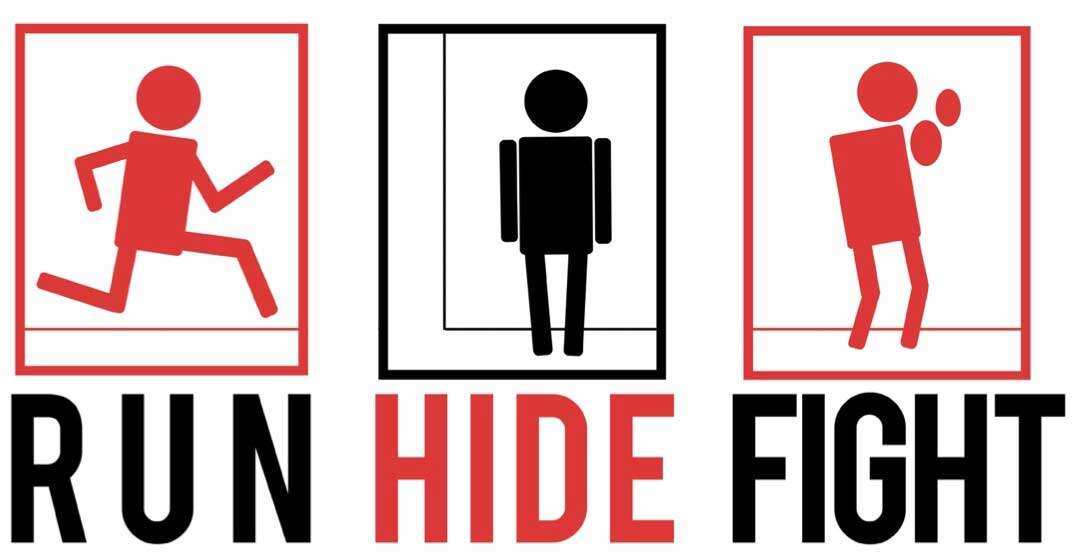Colin Cobb | Staff Writer | colin.cobb@hotmail.com
Illustration by Ashley Fairbourne
“If you are ever to find yourself in the middle of an active shooter event, your survival may depend on whether or not you have a plan,” says the voiceover on “RUN. HIDE. FIGHT.,” a five minute training video produced by Houston’s police department.
There are other training videos available to prepare for active shooters, but “RUN. HIDE. FIGHT.” has become the most popular, being utilized in trainings across the nation, including those put on by UVU.
The video makes it clear that the plan doesn’t have to be complicated and produces its three eponymous options: one can run, one can hide, or one can fight.
“We don’t necessarily advocate fighting,” says Robin Ebmeyer, director of Emergency Risk Management Services at UVU. “But if [the shooter] is here right now in front of me and I haven’t thought about what I’m going to do, then I’m not going to do anything.”
Concern on college campuses is commonly traced back to the grisly shooting at Virginia Tech in April of 2007. But America has seen almost 100 public shootings since the tragedy at Sandy Hooks, which took place almost two years ago in December 2012. Unfortunately, because of the sheer number, the threat of active shooters has almost become routine.
65 percent of UVU students appear to be unconcerned with the possibility of a school shooting on campus, according to a recent omnibus survey. But an even more startling number is the 79 percent who claim that they’re unfamiliar with UVU’s response plan in such an emergency.
“Student safety is a paramount concern,” says President Matthew Holland. “The realities are that we are vulnerable, like every other educational institution…but I hope that what we’re doing will significantly minimize the chances of it happening.”
Despite the lack of concern and knowledge among the student body, Ebmeyer and her team have been working tirelessly to prepare the school if such an event should occur. Following the mandate of President Holland, who partnered with Emergency Risk Management Services in developing safe campus training even before Sandy Hooks, Ebmeyer has personally overseen more than 140 safety training courses for UVU faculty and staff.
“The hope is if the employees are trained and feel like they know what to do, then they’re going to be able to guide the students,” says Ebmeyer. “The students are the transients. Some of them are here for a while, but they’re the ones that kind of come and go. It’s really hard to train them and keep them up to date.”
Ebmeyer says that for students, in lieu of training they’re relying on communicating the danger in the moment and trusting that faculty members can act on the preparation they’ve received.
With that focus on communication, UVU has implemented opt-in text message alerts which now have more than 22,000 subscribers. They also hope that the UVU app will soon have push notifications to alert users of any danger on campus.
For those not opted in to those services though, the fire alarm systems in newer buildings such as the Library, Science Building and the Student Life & Wellness Center are wired with a PA voice alert system for fast, verbal alerts.
And finally, certain faculty members and campus police have access to the iNotify system, which sends messages through the digital signage and computer desktops across campus.
These efforts are, of course, only a last-ditch response for Ebmeyer, who has files of studies and news articles highlighted with important information about active shooters open on her desk. She hopes the event she’s spent so much time preparing for never takes place.
Weekly, she convenes with the Behavioral Assessment Team on campus, where they discuss possible threats and then work to diffuse them. It’s a practice they believe has been successful, and so far it seems to be.
Students may not be familiar with the response, but the more permanent members of UVU’s community seem to be. It’s this preparation that could account for the 89 percent of UVU students who report feeling safe on campus.
“I’m not comfortable enough not to plan for it.,” says Ebmeyer. “So we plan for it and hope that it doesn’t happen.”










